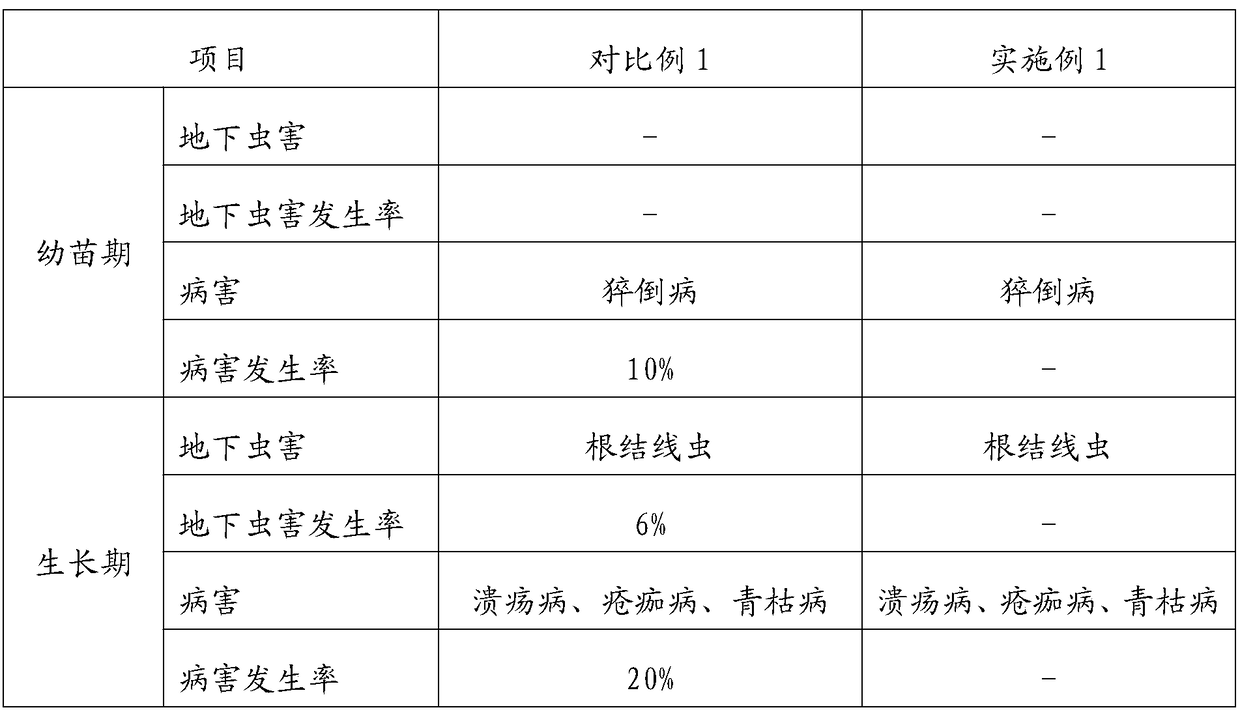Non-toxic, bud-rich tomato tree cultivation method for grafting scions
A cultivation method and tomato technology, applied in grafting, fruit tree cultivation and other directions, can solve the problems of increased disease susceptibility rate of grafted seedlings, decreased graft survival rate, unacceptable to growers, etc., to improve germination uniformity and germination rate, prevent soil The effect of spreading diseases and insect pests and avoiding contaminating germs
- Summary
- Abstract
- Description
- Claims
- Application Information
AI Technical Summary
Problems solved by technology
Method used
Image
Examples
Embodiment 1
[0071] The nontoxic multi-bud tomato tree cultivation method for grafting scion of the present embodiment comprises the steps:
[0072] Step 1: Disinfect the planting substrate
[0073] Spread a layer of PTFE film at the bottom of the cultivation tank, and then spread a sterilized substrate with a thickness of 15 cm on the PTFE film. Spread a layer of PTFE film on the bottom of the cultivation tank to isolate the soil and prevent soil-borne diseases and insect pests.
[0074] Described sterilized matrix is prepared by the following method: the mass percentage is 50% calcium cyanamide, the mass percentage is 55% dexon and the mass percentage is 30% Dolphin wettable powder, by weight After 2:1:1 mixing and mixing, a mixed powder is obtained. The mixed solvent can effectively prevent the occurrence of soil-borne diseases such as tomato ground mite and root-knot nematode, can quickly kill and disinfect the diseases caused by fungi, bacteria and Fusarium, and can prevent the oc...
Embodiment 2
[0101]The nontoxic multi-bud tomato tree cultivation method for grafting scion of the present embodiment comprises the steps:
[0102] Step 1: Disinfect the planting substrate
[0103] Spread a layer of FEP film at the bottom of the cultivation tank, and then spread a sterilized substrate with a thickness of 18cm on the FEP film. Spread a layer of FEP film on the bottom of the cultivation tank to isolate the soil and prevent soil-borne diseases and insect pests.
[0104] Described sterilized matrix is prepared by the following method: the mass percentage is 50% calcium cyanamide, the mass percentage is 55% dexon and the mass percentage is 30% Dolphin wettable powder, by weight After 3:1:1 mixing and mixing, a mixed powder is obtained. The mixed solvent can effectively prevent the occurrence of soil-borne diseases such as tomato ground mite and root-knot nematode, can quickly kill and disinfect the diseases caused by fungi, bacteria and Fusarium, and can prevent the occurre...
Embodiment 3
[0131] The nontoxic multi-bud tomato tree cultivation method for grafting scion of the present embodiment comprises the steps:
[0132] Step 1: Disinfect the planting substrate
[0133] Spread a layer of PFA film on the bottom of the cultivation tank, and then spread a sterilized substrate with a thickness of 20cm on the PFA film. Spread a layer of PFA film on the bottom of the cultivation tank to isolate the soil and prevent soil-borne diseases and insect pests.
[0134] Described sterilized matrix is prepared by the following method: the mass percentage is 50% calcium cyanamide, the mass percentage is 55% dexon and the mass percentage is 30% Dolphin wettable powder, by weight After 4:1:1 mixing and mixing, a mixed powder is obtained. The mixed solvent can effectively prevent the occurrence of soil-borne diseases such as tomato ground mite and root-knot nematode, can quickly kill and disinfect the diseases caused by fungi, bacteria and Fusarium, and can prevent the occurr...
PUM
 Login to View More
Login to View More Abstract
Description
Claims
Application Information
 Login to View More
Login to View More - R&D
- Intellectual Property
- Life Sciences
- Materials
- Tech Scout
- Unparalleled Data Quality
- Higher Quality Content
- 60% Fewer Hallucinations
Browse by: Latest US Patents, China's latest patents, Technical Efficacy Thesaurus, Application Domain, Technology Topic, Popular Technical Reports.
© 2025 PatSnap. All rights reserved.Legal|Privacy policy|Modern Slavery Act Transparency Statement|Sitemap|About US| Contact US: help@patsnap.com



